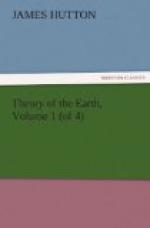An indefinite variety of those compositions of clay form a large portion of the present strata, all indurated and consolidated in various degrees; but this great quantity of siliceous, argillaceous, and other compound substances, in form of earth or impalpable sediment, corresponds perfectly with that quantity of those same substances which must have been prepared in the formation of so much gravel and sand, by the attrition of those bodies in the moving waters.
Therefore, from the consideration of those materials which compose the present land, we have reason to conclude, that, during the time this land was forming, by the collection of its materials at the bottom of the sea, there had been a former land containing materials similar to those which we find at present in examining the earth. We may also conclude, that there had been operations similar to those which we now find natural to the globe, and necessarily exerted in the actual formation of gravel, sand, and clay. But what we have now chiefly in view to illustrate is this, that there had then been in the ocean a system of animated beings, which propagated their species, and which have thus continued their several races to this day.
In order to be convinced of that truth, we have but to examine the strata of our earth, in which we find the remains of animals. In this examination, we not only discover every genus of animal which at present exists in the sea, but probably every species, and perhaps some species with which at present we are not acquainted. There are, indeed, varieties in those species, compared with the present animals which we examine, but no greater varieties than may perhaps be found among the same species in the different quarters of the globe. Therefore, the system of animal life, which had been maintained in the ancient sea, had not been different from that which now subsists, and of which it belongs to naturalists to know the history.
It is the nature of animal life to be ultimately supported from matter of vegetable production. Inflammable matter may be considered as the pabulum of life. This is prepared in the bodies of living plants, particularly in their leaves exposed to the sun and light. This inflammable matter, on the contrary, is consumed in animal bodies, where it produces heat or light, or both. Therefore, however animal matter, or the pabulum of life, may circulate through a series of digesting powers, it is constantly impaired or diminishing in the course of this economy, and, without the productive power of plants, it would finally be extinguished.[17]
[Note 17: See Dissertations on different subjects of Natural Philosophy, part II.]
The animals of the former world must have been sustained during indefinite successions of ages. The mean quantity of animal matter, therefore, must have been preserved by vegetable production, and the natural waste of inflammable substance repaired with continual addition; that is to say, the quantity of inflammable matter necessary to the animal consumption, must have been provided by means of vegetation. Hence we must conclude, that there had been a world of plants, as well as an ocean replenished with living animals.




